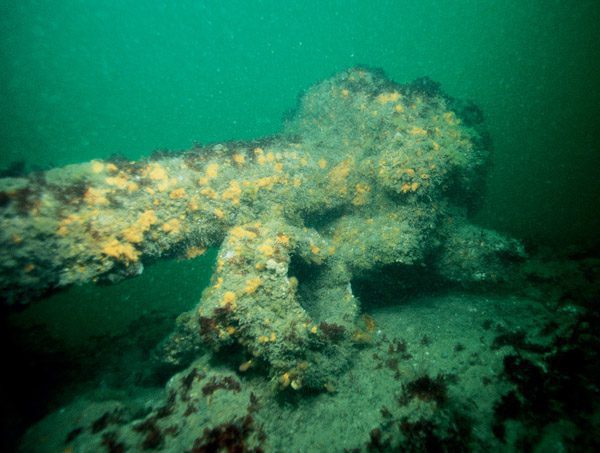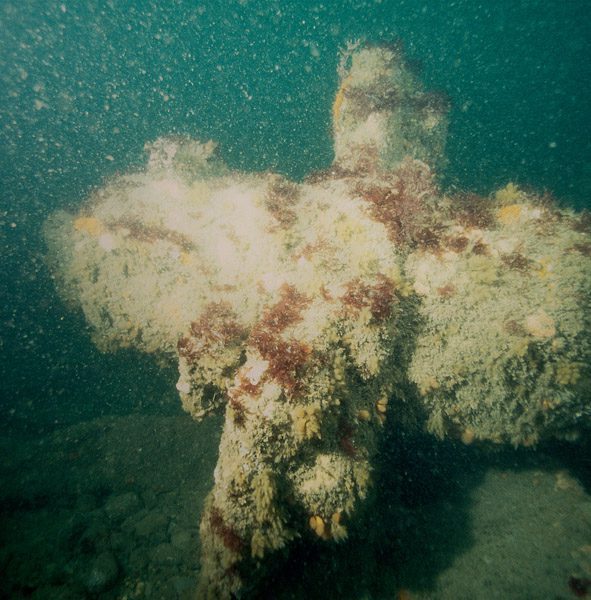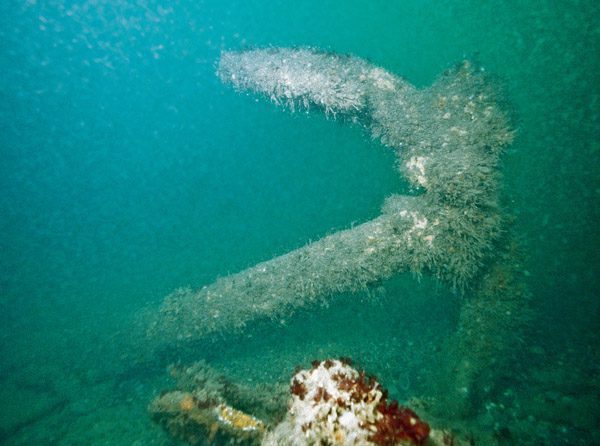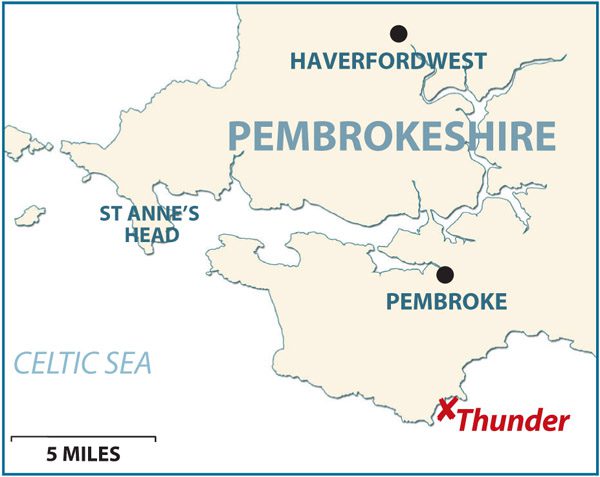We have a double-header for you to enjoy this month – two small vessels sunk within 10 years of each other in the mid-Victorian era off Pembrokeshire. JOHN LIDDIARD leads the tour, with MAX ELLIS providing the illustrations
First wreck in the Pembrokeshire double is the Thunder, a 610-ton iron coaster that foundered in calm conditions off Broad Haven (south) in 1889.
At just 17m to the seabed, it’s hardly surprising that the wreck has been comprehensively flattened except for the boiler (1), next to which Steve Lewis dropped the shot.
The boiler has rolled out of the starboard side of the wreck and is almost upside-down, with the three furnace openings now uppermost on its forward end.
A steam-valve (2) is just visible beneath it in the scour, polished shiny by the sand’s constant motion.
Aft of the boiler and onto the main line of the wreck, the Thunder’s engine is missing, but for one small iron valve (3).
With the major dockyard of Pembroke nearby and the shallow depth, I suspect that this could have been salvaged soon after the sinking. A shame, because as an inverted compound engine, where the steam acted on the pistons from below, it could have been interesting.
The propeller-shaft (4) leads a short distance aft through the remains of the keel and stern frame to a broken propeller (5), just a hub with the stubs of iron blades remaining. Next to the propeller, the rudder lies flat on the sand.

Now heading forwards, the boiler-mounts (6) are easily recognisable and clear of debris. Forward of the boiler, a single small cylinder is all that remains of an auxiliary engine, perhaps from a pump (7).
Our route now follows the line of the hull through loosely scattered debris from the second hold to the stub of the main mast (8). The remains of the mast-foot and deck-plate are still in place about the base of the mast.

Across the wreck, three ribs stand upright (9) on the port side of what would have been the forward hold.
Now in the area of the forecastle, a pair of upright pipes with flanges (10) would have provided steam to power the anchor-winch (11). Finally, a single Admiralty-pattern anchor lies right at the bow (12).

On a ship of this age and size, a hawse-pipe would not have been fitted, and the anchor simply dropped over the side of the bow. Some small fairleads on the port side would have been used to guide the cable.
THUNDERSTRUCK
THE THUNDER, tanker. BUILT 1853, SUNK 1889
THE 610-TON IRON STEAMSHIP Thunder was launched in 1853. Early steam engines were inefficient, and in 1880 she was fitted with a new 90hp inverted compound engine by CD Holmes & Co of Hull. The vessel was owned by the Thunder Steamship Company, managed by HP Archer of London.
Loaded with 620 tons of coal at Briton Ferry (on the River Neath, where the M4 now crosses above Port Talbot), at 8.30pm on 11 September, 1889, the Thunder departed for Belfast, a journey Captain William Morris would have made many times before.
It was a calm but hazy night and the Thunder was making 8 knots. At 1.30am on 12 September a fog signal was heard. Captain Morris adjusted the course and retired to his cabin, leaving the mate in charge.
As the fog grew denser, the Thunder’s speed was reduced to less than half. By 4.45 Captain Morris was back on the bridge. Breakers were heard, thought to be the race off St Govans Head, and he altered course again.
By 5am breakers were spotted immediately ahead beneath the cliffs. The engine was reversed, but the Thunder struck.
By 5.30am the rising tide had lifted the ship free, and Captain Morris made for Tenby. The pumps could not keep pace with incoming water, the boiler fires were extinguished and the crew took to the boats, watching the Thunder sink at 7am, some 500m offshore with the mast still showing. It was speculated that divers might save the vessel before bad weather set in.
The court of enquiry suspended Captain Morris’s licence for 12 months, questioning his knowledge of compass navigation and magnetic deviation caused by the iron ship, and stating that his navigation had made no allowance for the tide.
TOUR GUIDE
GETTING THERE: Follow the M4, A40 and A477 to Pembroke Dock, then cross the bridge to Neyland and follow the signs for the marina.
HOW TO FIND IT: Steve Lewis is keeping the exact position to himself for now, but the wreck lies roughly off Broad Haven (south), across the tide with the bow to the south-east. Ignore the position given in the Shipwreck Index (51 37.30N, 4 54.30W) – this is on dry land!
TIDES: Slack water is essential, and coincides with high water Milford Haven.
DIVING: Pembrokeshire Dive Charters, 01646 602942.
AIR: Air and nitrox from Old Mill Diving Services near Milford Haven, 01646 690190.
ACCOMMODATION: Pembrokeshire DC can arrange accommodation at the Lawrenny Castle Hotel in Neyland.
LAUNCHING: Slipways at Neyland and Dale. A slip in Tenby is closer, but access is difficult and use restricted during the busy summer months.
QUALIFICATIONS: Entry-level (at low-water slack).
FURTHER INFORMATION: Admiralty Chart 1076, Linney Head to Oxwich Point. Ordnance Survey Map 157, St David’s & Haverfordwest Area. Ordnance Survey Map 158, Tenby.
PROS: Relatively little-dived coaster, shallow enough for good light.
CONS: Far from the nearest slip.
DEPTH: -20 m
Thanks to Steve Lewis and Ron Young
Appeared in DIVER March 2012


